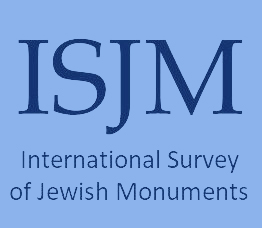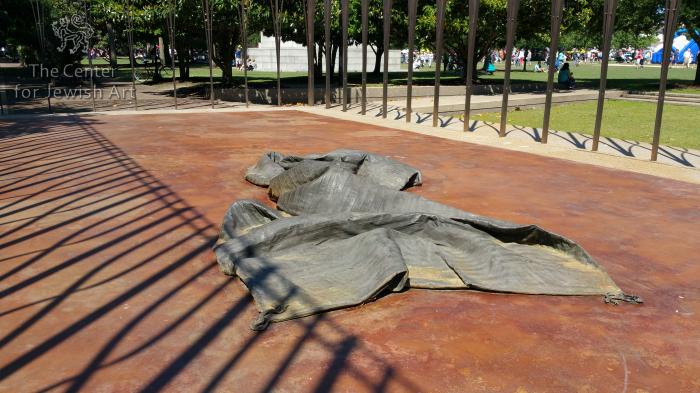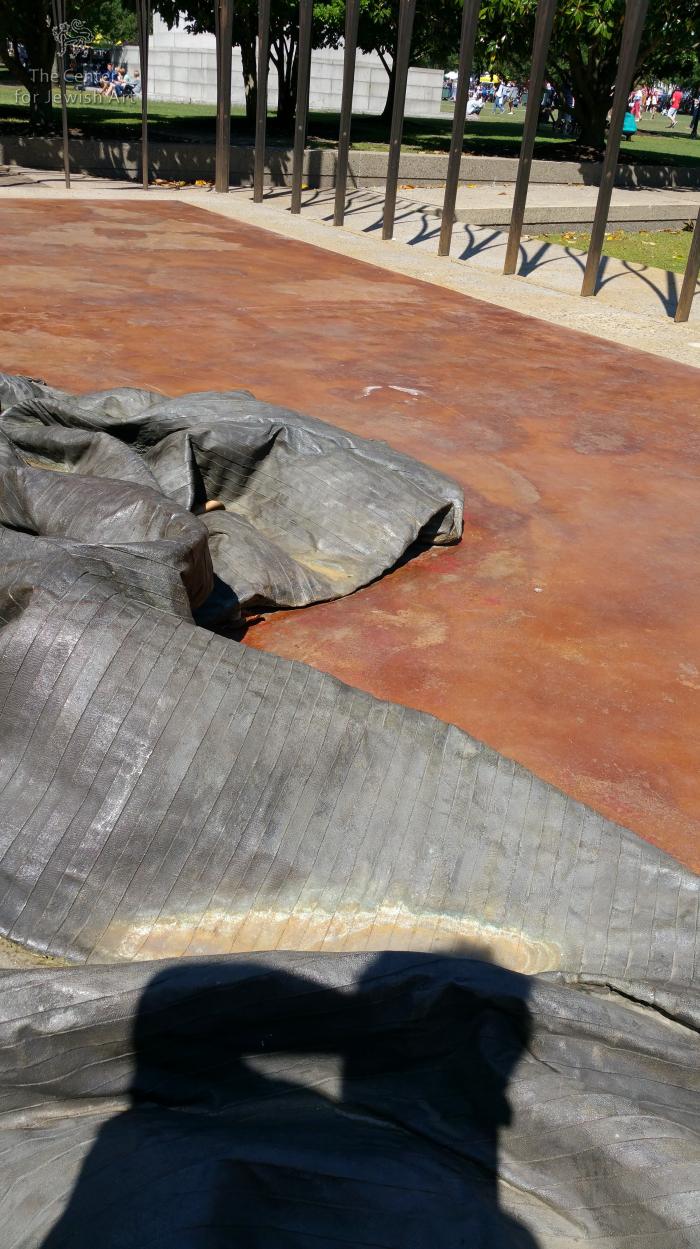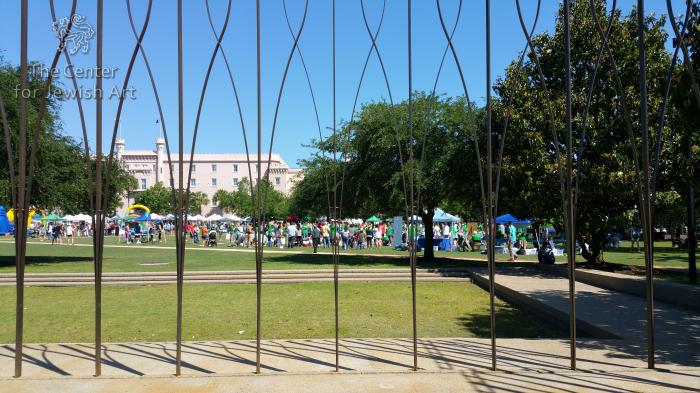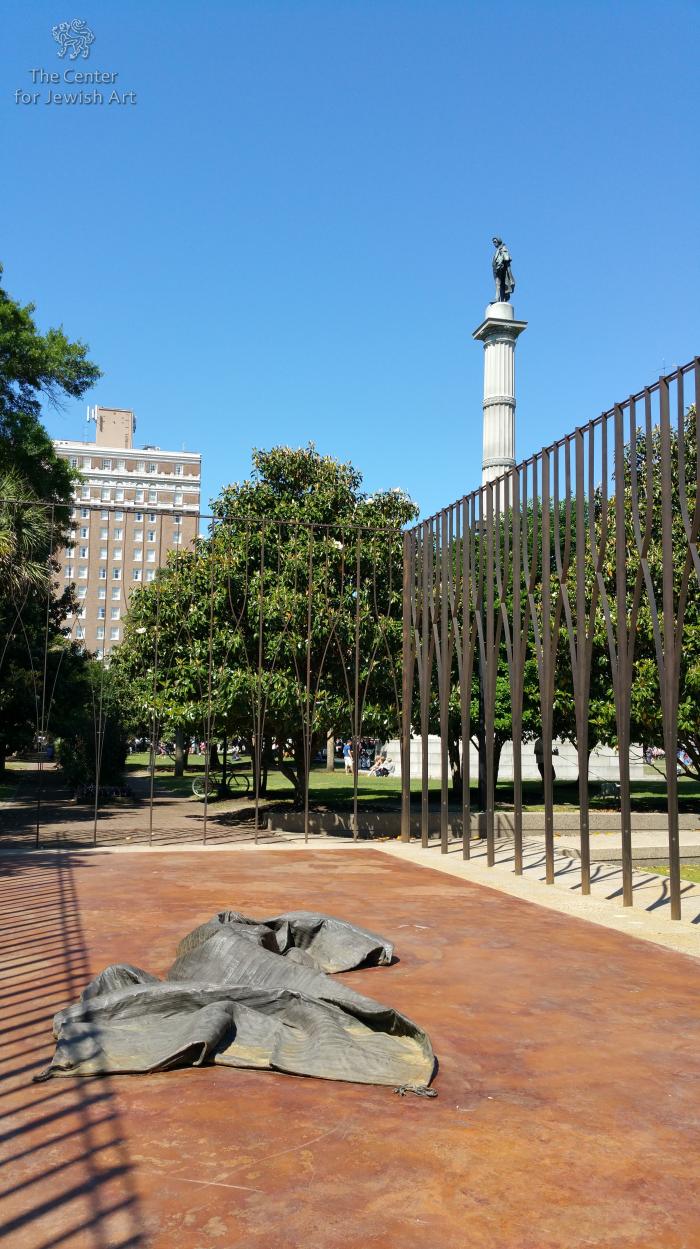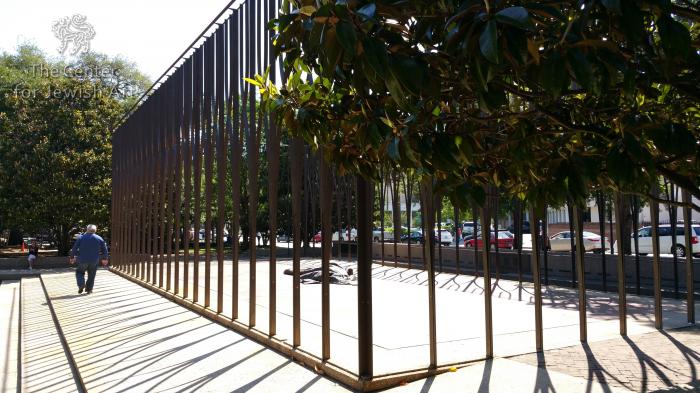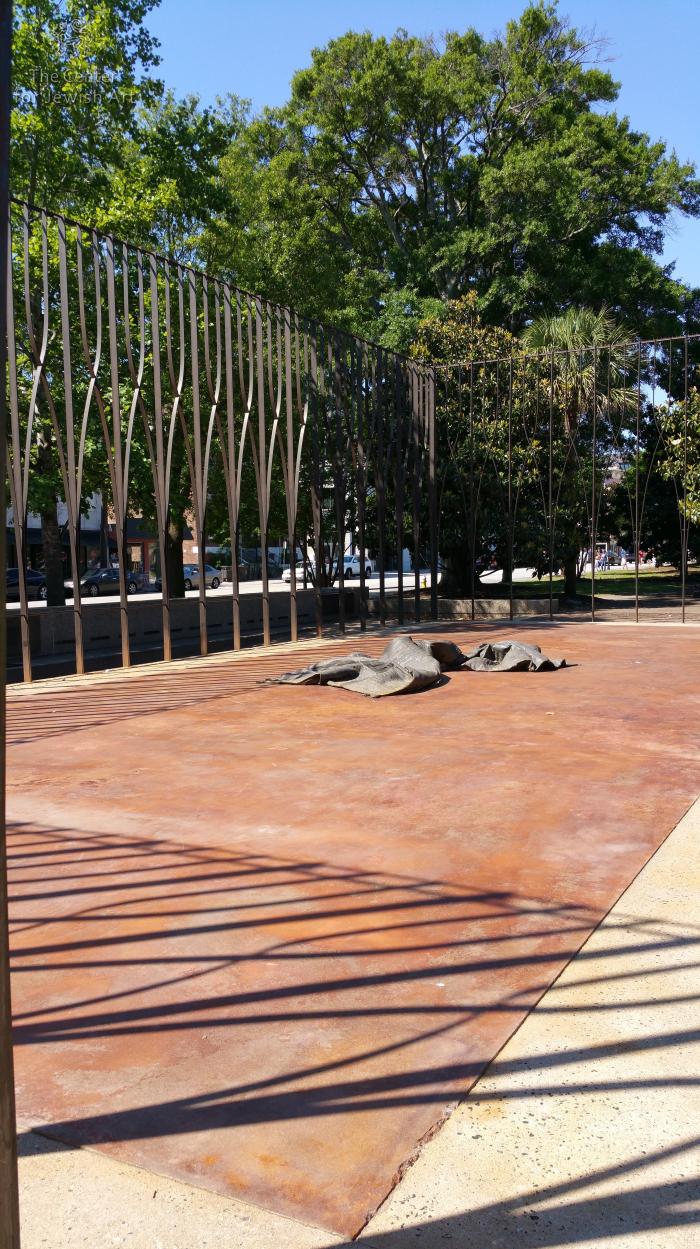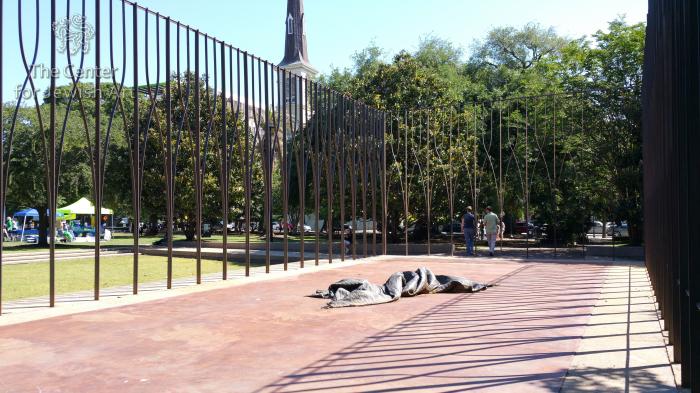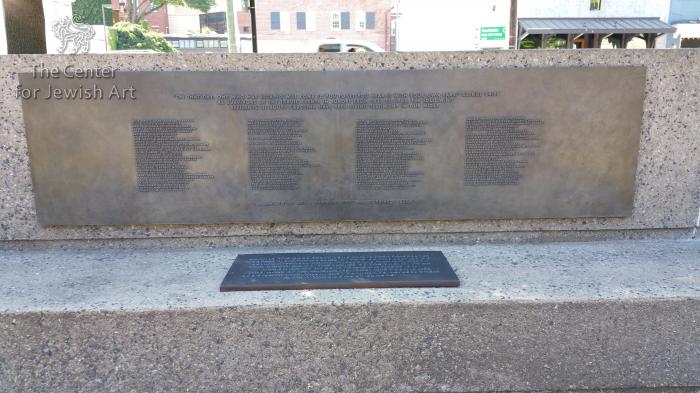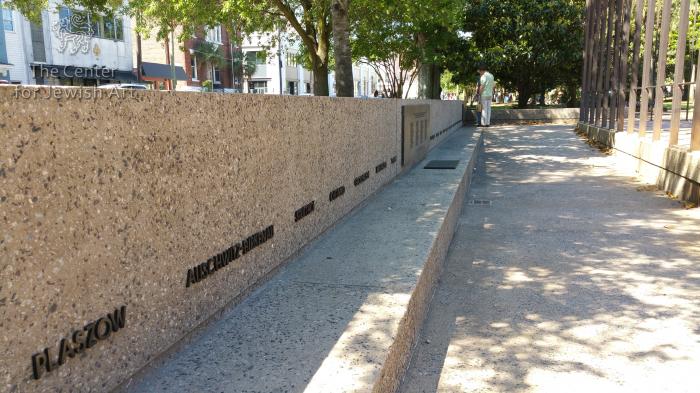Obj. ID: 42167 Holocaust Memorial in Charleston, SC, USA, 1999
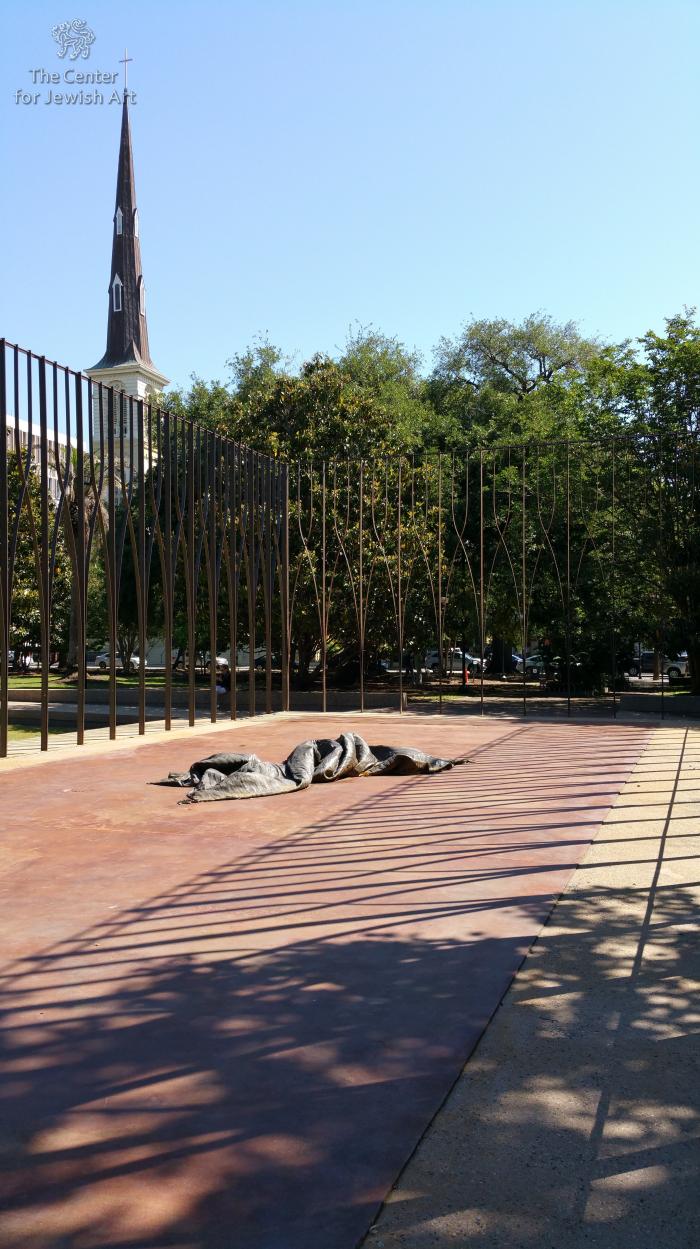
Who is Commemorated?
All victims of nazism, including Jews, political dissidents, homosexuals, the mentally and physically disabled, Roma (Gypsies), and Jehovah’s witnesses
Description
The central element is a lonely, discarded tallit, the Jewish prayer shawl used by men in the synagogue and in which for some it was customary to be wrapped for burial. Cast in bronze, the tallit lies on the floor of a rectangular space that can been seen as a synagogue, a prison, or even perhaps a gas chamber. Left behind, the tallit indicates prayer and life cut short, but also the rites of proper burial denied.
In 2015, architect Levi said the memorial was originally designed in three parts; the sanctuary, a place of reflection meant to “transcend even the terrible events of the mid-twentieth century;” the place of assembly; and then the place of remembrance [Boughton, 2015]. Three divisions of the monument recall the purposes of a synagogue - a house of gathering, a house of prayer, and study.
The north side is a rectangular, sunken lawn framed by graded steps, intended as a place of contemplation and a meeting ground for the annual Yom Ha Shoah (National Day of Holocaust Remembrance) ceremonies.
The center of the memorial, or sanctuary, is a rectangular space, about the same size as the meeting space. This is a raised platform screened by a two-story high screen of mill-finish stainless steel, that creates a series of narrow bays which taken together recall an eclosed synagogue sanctuary, on the pavement of which lies a lonely, discarded tallit the Jewish prayer shawl used by men in the synagogue – cast in bronze. The tallit is representative of the prayer – or the absence of it in the empty synagogue. For some Jews it was customary to be wrapped in a tallit for burial, so this is also a symbol of death. Left behind, the tallit indicates prayer and life cut short, but also the rites of proper burial denied.
The south side faces Calhoun Street and features a low wall with a built-in bench the tuns the entire length. Affixed to the wall that is the back of the bench are the names oof 21 concentration and death camps spelled out in applied bronze letters. At the far left and right of this wall are rectangular bronze blocks with inscriptions on their fronts and tops. In the center of the camp name is a large bronze plaque with a text detailing Holocaust history, and listing names of survivors living in South Carolina.
Inscriptions
Bronze block at west end of wall, inscription on front:
IN MEMORIUM
1999
Bronze block at west end of wall, inscription on top:
THIS MEMORIAL ARISES OUT OF A COLLABORATION BETWEEN THE BOARD OF OFFICERS
OF THE SUMTER GUARD AND WASHINGTON LIGHT INFANTRY, THE CITY OF CHARLESTON, AND THE CHARLESTON JEWISH FEDERATION.
IT IS ERECTED TO REMEMBER THOSE WHO WERE MURDERED IN THE HOLOCAUST IN
EUROPE BETWEEN 1933 - 1945, AND TO HONOR THE SURVIVORS WHO CAME TO
OUTH CAROLINA TO REBUILD THEIR LIVES.
WE REMEMBER THE HOLOCAUST TO ALERT OURSELVES TO THE DANGERS OF PREJUDICE,
TO EXPRESS OUR OUTRAGE AT THE SCOURGE OF RACISM, AND TO WARN THE WORLD
THAT RACISM CAN LEAD TO GENOCIDE.
THE TALLIT IS A FOUR CORNERED GARMENT WORN BY MANY JEWS AT PRAYER.
IT IS CUSTOMARY FOR JEWS TO USE THE TALLIT AS A BURIAL SHROUD
WITH ONE OF ITS FOUR FRINGES REMOVED AS A SYMBOL OF DEATH AND MOURNING.
On front of bronze block set in wall:
IN MEMORIAM
TO THOSE WHO PERISHED IN THE HOLOCAUST 1933 - 1945
On top of bronze block set in wall:
From 1933 until 1945, the National Socialist (Nazi) regime in Germany implemented a racial theory declaring the “German Aryan Race” superior. The Nazis used this perverse Theory and their military and industrial might to dominate Europe and to separate, imprison and ultimately destroy millions of human beings. Those who the Nazis deemed undesirable and sought to eliminate included political dissidents, homosexuals, the mentally and physically disabled, Roma (Gypsies) and Jehovah’s witnesses. But their chief victims were six million Jews.
What began as racial laws to strip Jews of their livelihood, their property and their civil rights accelerated into a campaign to systematically slaughter millions of men, women and children. By 1942, the machinery of mass murder was in full operation. Jews and other victims from all over Europe were sent to some 9000 concentration and labor camps throughout Europe, and to the killing centers at Auschwitz-Birkenau, Sobibor, Majdanek, Treblinka, Belzec and Chelmno located in Poland.
The denial of Human Rights with advanced technology and a pitiless will to dominate, caused the death of innocent millions and the annihilation of most of the Jews of Europe.
On side wall, central plaque applied to wall:
ON THAT DAY, ONE WHO HAS ESCAPED WILL COME TO YOU TO LET YOU HEAR IT WITH YOUR OWN EARS.” EZEKIEL 24:26
AS SURVIVORS OF THE TRAGIC EVENTS IN EUROPE FROM 1933 TO 1945, THE FOLLOWING RESIDENTS OF SOUTH CAROLINA HAVE BEEN LIVING TESTIMONY IN OUR MIDST.
Four columns of names
“…WE TODAY ARE A REMNANT THAT HAS SURVIVED.” EZRA 9:15
On side wall, a plaque set horizontally:
DURING THE HOLOCAUST, JEWS AND OTHER PERSECUTED
PEOPLES WERE IMPRISONED IN 10S OF THOUSANDS OF
CONCENTRATION CAMPS, INCLUDING TRANSIT, LABOR
AND DEATH CAMPS. THE NAMES OF THE TWENTY FOUR
MAJOR CAMPS IN EUROPE ARE INSCRIBED ON
THIS WALL OF REMEMBRANCE. THEY ARE POSITIONED
GEOGRAPHICALLY FROM EAST TO WEST TO REFLECT THEIR
EXTENT THROUGHOUT EUROPE.
Kaiserwald
Janowska
Sobibor
Belzec
Majdanek
Treblinka
Plaszow
Auschwitz-Birhenau
Stuthof
Chelmno
Gross-Rosen
Mauthausen
Terezin
CENTRAL PLAQUE
Sachsenhausen
Oranienburg
Ravensbruck
Flossenburg
Buchenwald
Dora-Mittlebau/mordhausen
Neuengamme
Dachau
Plaque set in the ground near western edge of memorial:
DEDICATED ON APRIL 13TH, 1999, BY THE HONORABLE JOSEPH P RILEY, JR.
MAYOR OF THE CITY OF CHARLESTON.
DAVID POPOWSKI, CHAIR, CHARLESTON HOLOCAUST MEMORIAL COMMITTEE
ANITA G ZUCKER, FUNDRAISING CHAIR
JEFFREY M ROSENBLUM, AIA, DESIGN CHAIR
JENNIFER ENRIQUEZ PHILLIPS, DEVELOPMENT CHAIR
PINCUS KOLENDER, JOSEPH ENGEL, CHARLES MARKOWITZ,
AND SAM GREEN, HONORARY CHAIRS
JERRY AND ANITA ZUCKER, CORNERSTONE BENEFACTORS
MEMORIAL PROJECT TEAM: JONATHAN LEVI ARCHITECTS, INC., BOSTON, MA
(FORMERLY STEIN/LEVI ARCHITECTS, INC.)
DESIGN WORKS, L.C., CHARLESTON,
SCSCULPTOR: JONATHAN LEVI
CONTRACTOR: STIER, KENT AND CANADY, INC., CHARLESTON, SC
CHARLESTON HOLOCAUST MEMORIAL
Commissioned by
Charleston Jewish Federation*Memorials | Holocaust-related memorial | Memorial to Roma victims of Nazism
*Memorials | Holocaust-related memorial | Memorial to homosexual victims of Nazism
*Memorials | Holocaust-related memorial | Memorial to victims of Nazism, including Jews
Bronze
Stainless steel
From David Popowski, Chair, Charleston Holocaust Memorial Committee:
“The five-year period of design, fundraising, and construction was time-consuming, at times contentious, and meaningful. A committee of approximately 20 members of the Jewish community, with survivors Joe Engel, Pincus Kolender, Charles Markowitz, and Sam Greene playing key roles, oversaw the project. An executive committee consisting of Jennifer Phillips, Anita Zucker, Jeffrey Rosenblum, and myself handled the daily tasks and issues. Jennifer Phillips was at the center of our work, devoting her energies full-time to the project. Mayor Riley assigned City Parks Director Steven Livingston and head of Cultural Affairs Ellen Dressler Moryl to the committee, and they worked diligently with us.
From a group of 15 applicants, architect Jonathan Levi of Boston and landscape design firm Design Works of Charleston were selected. At the recommendation of Jeffrey Rosenblum and respected contractor and Jewish community leader Raymond Frisch, the committee chose contractors Stier, Kent & Canady to build the memorial. After receiving their cost estimate of approximately $500,000, we began the fundraising effort, led by Anita. Our timing was fortuitous because the economy was robust and we had broad support from the community at large. Contributions came from countless individuals and—owing largely to Anita’s work—from numerous corporations.
The selection of the site was mildly controversial. A few people preferred the old museum property on Rutledge Avenue, but the consensus was that Marion Square, fronting Calhoun Street, was best because of its visibility. There also was some disagreement about the design proposed by the professionals: some critics wanted a more striking structure and others a greater emphasis on Jewish symbols. The committee finally approved the memorial as you see it now. There was no discussion about the irony of it being next to a towering statue of former vice president and slavery advocate John C. Calhoun. Marion Square, by the way, is owned by the Washington Light Infantry and Sumter Guard and is leased to the City of Charleston. Their member and former South Carolina State Senator Robert Scarborough represented those organizations and skillfully handled the collaboration.
We broke ground on July 23, 1997, and on June 6, 1999 ... we dedicated the memorial at Marion Square before a crowd of 1,500 people.” [Popowski]
In 2015 additional plaques were added listing the names of Shoah survivors who settled in South Carolina.
Boughton, Melissa. “City’s Holocaust Memorial rededicated: ‘We will never forget you,’” The Post and Courier, April 18, 2015, https://www.postandcourier.com/archives/city-s-holocaust-memorial-rededicated-we-will-never-forget-you/article_00eca74d-ce22-54aa-9b57-e685f8672b51.html (accessed December 13, 2021)
Gruber, Samuel D. “USA: Charleston's Holocaust Memorial in Shadow of Calhoun Monument” Samuel Gruber’s Jewish Art & Monuments, Feb. 26, 2017, https://samgrubersjewishartmonuments.blogspot.com/2017/02/usa-charlestons-holocaust-memorial-in.html (accessed December 13, 2021)
Jonathan Levi Architects, “Holocaust Memorial in Charleston: Integrated Urban Planning, Architecture & Sculpture,” No date., https://www.leviarc.com/assets/profile-holocaustmem.pdf (accessed December 13, 2021)
Popowski, David. “Building a Memorial in Marion Square,” Jewish Historical Society of South Carolina (no date)., https://jhssc.org/building-a-memorial-in-marion-square/ (accessed December 13, 2021)



